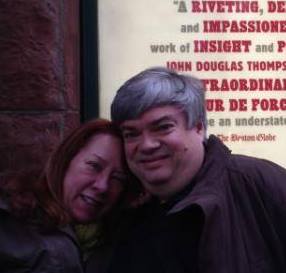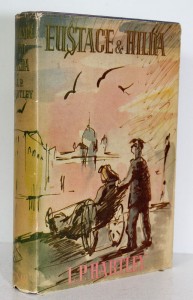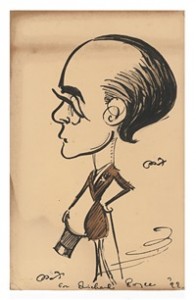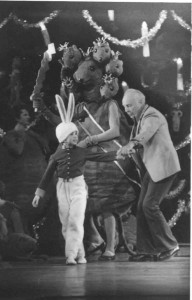 “A success that has outlived its usefulness may, in the end, be more damaging than failure.”
“A success that has outlived its usefulness may, in the end, be more damaging than failure.”
Peter Drucker, Management: Tasks, Responsibilities, Practices
Terry Teachout on the arts in New York City
 I don’t need to tell any of you that 2014 was appalling in countless ways. That said, it was also the year that Satchmo at the Waldorf came to New York and ran off Broadway for four wonderful months. In the larger scheme of things, I suppose that event must go under the heading of being thankful for small favors. To me, though, it was a grand and glorious thing for which I will forever after be unimaginably grateful to my irreplaceable collaborators, as well as to Mrs. T, without whose steadfast and inspiring love I would never have been able to summon up sufficient nerve to try my hand at writing anything so unlikely as a play.
I don’t need to tell any of you that 2014 was appalling in countless ways. That said, it was also the year that Satchmo at the Waldorf came to New York and ran off Broadway for four wonderful months. In the larger scheme of things, I suppose that event must go under the heading of being thankful for small favors. To me, though, it was a grand and glorious thing for which I will forever after be unimaginably grateful to my irreplaceable collaborators, as well as to Mrs. T, without whose steadfast and inspiring love I would never have been able to summon up sufficient nerve to try my hand at writing anything so unlikely as a play.
And now…what? Well, the following posting first appeared in this space on January 1, 2013. Two years later, I can’t put it any better.
* * *
A year ago today I was with Mrs. T on Sanibel Island. I’d just learned that my mother was dying, and I was doing my best to come to terms with the knowledge. A week later I got a call from Massachusetts informing me that Shakespeare & Company had decided to produce my first play. In the months that followed, I got a Guggenheim Fellowship, drove down Highway 1 from San Francisco to San Diego, spent five weeks at the MacDowell Colony, saw Satchmo at the Waldorf produced by three regional theaters, made four new friends, finished writing the greater part of Duke: A Life of Duke Ellington, and stood by my mother’s open grave. No matter what 2013 turns out to be like, it won’t be like that. It couldn’t.
 I brought 2012 to a close yesterday by writing the first three thousand words of the antepenultimate chapter of Duke. A year from now, barring some unthinkable catastrophe, Duke will be in print and I’ll have seen a hundred more shows. Beyond that, I’ve no idea what to expect. I don’t know what my next book will be, or whether Satchmo will have a life after its most recent closing night. I know where I’ll be for the next six weeks…and that’s all.
I brought 2012 to a close yesterday by writing the first three thousand words of the antepenultimate chapter of Duke. A year from now, barring some unthinkable catastrophe, Duke will be in print and I’ll have seen a hundred more shows. Beyond that, I’ve no idea what to expect. I don’t know what my next book will be, or whether Satchmo will have a life after its most recent closing night. I know where I’ll be for the next six weeks…and that’s all.
Is it enough? It’d better be.
I once quoted in this space the following words of Ogden Nash. It seems fitting to repeat them today:
Come, children, gather round my knee;
Something is about to be.
Tonight’s December Thirty-First,
Something is about to burst.
The clock is crouching, dark and small,
Like a time bomb in the hall.
Hark! It’s midnight, children dear.
Duck! Here comes another year.
To all of you who, like me, suspect that chance is in the saddle and rides mankind, I hope that the year to come treats you not unkindly, and that your lives, like mine, will be warmed by hope and filled with love.
Since Mrs. T and I will be spending the next two months in Florida, we took the precaution of shipping some of our stuff ahead of us. I sent a box containing books and DVDs. These are the books I plan to read on the beach and elsewhere. Some are new to me, some not:
• Jens Malte Fischer, Gustav Mahler
 • L.P. Hartley, Eustace and Hilda
• L.P. Hartley, Eustace and Hilda
• Philip Glass, Words Without Music (which I read yesterday)
• Hugh MacLennan, The Watch that Ends the Night (which I thought might go well with Beware of Pity)
• John P. Marquand, North of Grand Central
• V.S. Naipaul, A House for Mr. Biswas
• Honor Tracy, The Straight and Narrow Path
• Anthony Trollope, Phineas Finn and Phineas Redux
• Evelyn Waugh, Sword of Honour
• Edith Wharton, The House of Mirth and The Age of Innocence
• Stefan Zweig, Beware of Pity (which I read on the train) and The World of Yesterday
Make of that list what you will!
 I posted the following resolutions in this space eight years ago tomorrow:
I posted the following resolutions in this space eight years ago tomorrow:
• To finish Hotter Than That: A Life of Louis Armstrong. I changed the title to Pops, but otherwise done and done.
• To see fewer plays—and write more thoughtfully about the ones I do see. If anything, I now see more plays than I did eight years ago. Whether or not I write more thoughtfully about them is, of course, for others to say.
• To spend more time listening to music, not in the background or on the fly, but with the total concentration and involvement that it deserves. Didn’t happen, and I blush to admit it.
• To read Bleak House and War and Peace at long last, and report on my progress in this space. Ditto.
• To go to the gym four days a week, every week. Ditto redux.
• To take more time off. I’ve made some headway in this area, though not as much as I’d like.
• To visit the Grand Canyon. Alas, this longed-for pilgrimage is still on my list of undone things to do.
That was the last time I made any New Year’s resolutions, public or otherwise.
Five years later, I posted as follows:
I’m not making any clever resolutions this year—I’m too distracted by my mother’s illness, and 2011 was so complicated a mixture of success and sorrow that I scarcely know what to think about the year that’s just arrived. I’ll try my best to be a good husband, a good son, a good friend, and a good writer, and that will have to do.
I remain similarly disinclined to year’s-end hubris as 2014 heads out the door. As far as I’m concerned, it’ll be more than enough to be kind and work hard. Or, in the ever-appropriate words of Henry James, “Be generous and delicate and pursue the prize.”
 Max Beerbohm quoted those words to S.N. Behrman when the playwright visited him for the last time in 1955:
Max Beerbohm quoted those words to S.N. Behrman when the playwright visited him for the last time in 1955:
I knew I had to leave. I hated to leave. Max went on, “Do you know my favorite line of Henry James?”
I could see that he was not really expecting an answer from me—that he was communing with himself.
“It is ‘Be generous and delicate and pursue the prize.’” Max’s eyes were still fixed on the sun-dotted sea. “He didn’t always live up to it, of course. Who can? But in his work he did live up to it. It was his mask.” There was a pause. Max looked at me and smiled. “If you live up to a good manner long enough, don’t you know, perhaps it will become first nature to you, instead of second, or third.”
Perhaps it will. Sixty years later, I shall do my best to find out.
* * *
Max Beerbohm reads “The Crime” (from And Even Now) and “London Revisited” (originally broadcast on the BBC in 1936). These recordings were made for Angel and released on LP in 1955, a year before Beerbohm’s death. They have never been reissued in any format:
 A sound film of NBC’s first TV broadcast, which took place in 1936. To read more about this program, go here:
A sound film of NBC’s first TV broadcast, which took place in 1936. To read more about this program, go here:
(This is the latest in a series of arts-related videos that appear in this space each Monday and Wednesday.)
 I recently saw a small-town Nutcracker danced by an ensemble of Connecticut students. I don’t usually have occasion to attend such homely events, but I had a horse in the race—Ian, my nephew, played Dr. Stahlbaum, the genial host of the first-act party scene—and I was curious to find out what America’s best-loved ballet looks like when done by amateurs. You can always learn from watching an amateur theatrical performance, just as you can learn a lot about what it means for a painting to be of “museum quality” by looking at the not-quite-masterpieces by major artists that hang in so many of America’s smaller regional museums. So Mrs. T and I went to Ian’s Nutcracker, and though we were admittedly present as an act of pure family loyalty, I ended up getting quite a bit more out of it than I expected.
I recently saw a small-town Nutcracker danced by an ensemble of Connecticut students. I don’t usually have occasion to attend such homely events, but I had a horse in the race—Ian, my nephew, played Dr. Stahlbaum, the genial host of the first-act party scene—and I was curious to find out what America’s best-loved ballet looks like when done by amateurs. You can always learn from watching an amateur theatrical performance, just as you can learn a lot about what it means for a painting to be of “museum quality” by looking at the not-quite-masterpieces by major artists that hang in so many of America’s smaller regional museums. So Mrs. T and I went to Ian’s Nutcracker, and though we were admittedly present as an act of pure family loyalty, I ended up getting quite a bit more out of it than I expected.
As we settled into our seats and the taped sounds of Tchaikovsky’s “Miniature Overture” filled the auditorium, I realized with a start that it had been well over a decade since I’d last been to a live performance of The Nutcracker. Back in my dance-critic days, I used to see New York City Ballet do George Balanchine’s 1954 version two or three times each season, and I also went out of my way to catch The Hard Nut, Mark Morris’ updated Nutcracker, whenever it came to New York. Alas, I now spend so many of my evenings seeing plays that I don’t have time to go to the ballet other than sporadically, and on the rare occasions when I do, The Nutcracker isn’t high on my list of priorities. Yet I don’t see why it shouldn’t be, for Balanchine’s Nutcracker is one of his greatest achievements, a genuinely popular work of art that is also a top-tier masterpiece.
 It was, I suppose, inevitable that some art-hating moron would eventually get around to decrying the alleged “racism” of the gentle national stereotypes that Balanchine uses with the utmost affection in his second-act character dances. Far more interesting, in any case, is the first-act pantomime scene, an idealized stage version of a family Christmas party that Arlene Croce famously praised for its “seductive blend, so typically Balanchinean, of real fantasy and fantastic realism.”
It was, I suppose, inevitable that some art-hating moron would eventually get around to decrying the alleged “racism” of the gentle national stereotypes that Balanchine uses with the utmost affection in his second-act character dances. Far more interesting, in any case, is the first-act pantomime scene, an idealized stage version of a family Christmas party that Arlene Croce famously praised for its “seductive blend, so typically Balanchinean, of real fantasy and fantastic realism.”
That scene comforted me when, a quarter-century ago, the inexorable press of work forced me to spend Christmas alone in New York, the one and only time in my entire life when I’ve been away from my family for the holidays. I described the occasion a few years after the fact in a memoir of my small-town childhood and youth:
I popped a frozen pizza into the oven and went into the living room, which was bereft of Christmas decorations. (It is as hard to put up a Christmas tree for yourself as it is to cook for yourself.) I put on a record of The Nutcracker. Then I curled up on the couch with my cats, my presents, and my tin of cookies and thought about the Nutcracker I had seen at Lincoln Center a few days before. Something told me that watching The Nutcracker in a theater full of children would cheer me up, so I chose a Saturday matinee. Kyra Nichols, my favorite ballerina, was dancing that afternoon, and I expected to enjoy myself. I did, too, but not in the way I had expected. George Balanchine’s version of The Nutcracker begins with a Christmas Eve family party. The setting is a large, homey-looking living room filled with children who exchange presents, play leapfrog, and chase each other around. As the curtain went up and the children began to play, my eyes filled with tears. It was all so familiar. It had all been such a long time ago.
 I thought of that far-off matinee as I watched the first act of The Nutcracker in Connecticut. Of course I love it because it reminds me of the wonderful Christmas-eve parties that my mother’s family gave each year, but I admire it for other, more specifically aesthetic reasons. “For years Balanchine’s Act I has been taken for granted because it’s so simple and ‘has no dancing,’” Arlene Croce wrote in 1974. “It contains the heart of his genius.” So it does, and Amy Chibeau staged her own version with a clarity and solidity that reminded me of just how conceptually strong the party scene is, whether in Balanchine’s now-iconic version or in alternate versions that bear his unmistakable stamp.
I thought of that far-off matinee as I watched the first act of The Nutcracker in Connecticut. Of course I love it because it reminds me of the wonderful Christmas-eve parties that my mother’s family gave each year, but I admire it for other, more specifically aesthetic reasons. “For years Balanchine’s Act I has been taken for granted because it’s so simple and ‘has no dancing,’” Arlene Croce wrote in 1974. “It contains the heart of his genius.” So it does, and Amy Chibeau staged her own version with a clarity and solidity that reminded me of just how conceptually strong the party scene is, whether in Balanchine’s now-iconic version or in alternate versions that bear his unmistakable stamp.
For the record, my nephew was a very good Stahlbaum, unselfconsciously serious and completely immersed in his part. The second-act dancing was inevitably uneven, but I was as charmed by the children in the cast as were their doting parents, and Tchaikovsky’s gorgeous score took up the slack whenever things went askew on stage or backstage.
“You know, I’m really surprised how much I enjoyed myself today,” I said to Mrs. T as we drove home after the show.
“I’m not,” she replied. “I saw you crying during the first act.”
* * *
The opening scene from New York City Ballet’s 1993 film of The Nutcracker, choreographed by George Balanchine and directed by Emile Ardolino, with Robert LaFosse and Heather Watts as the Stahlbaums:
My days are for the most part happily uneventful. I always sleep late. I usually take my mother out to lunch (nowhere fancy–there aren’t any fancy places to take her in Smalltown!), after which we run whatever errands may need running. I brought home a couple of unfinished pieces that require my attention, but I haven’t yet started working on them. My brother and his family, who live three blocks away, frequently poke their heads in after dinner; otherwise, my mother and I do the dishes, watch a little TV or a movie, and chat contentedly about old times, local gossip, and whatever I may have been up to since my last visit home. She goes to bed around ten-thirty, after which I surf the Web, answer the day’s e-mail, blog a bit, and read myself to sleep….
Read the whole thing here.
| M | T | W | T | F | S | S |
|---|---|---|---|---|---|---|
| 1 | 2 | 3 | 4 | |||
| 5 | 6 | 7 | 8 | 9 | 10 | 11 |
| 12 | 13 | 14 | 15 | 16 | 17 | 18 |
| 19 | 20 | 21 | 22 | 23 | 24 | 25 |
| 26 | 27 | 28 | 29 | 30 | 31 | |
An ArtsJournal Blog